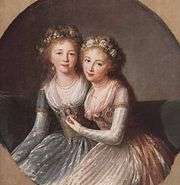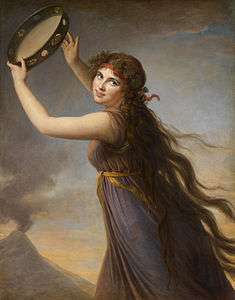Élisabeth Louise Vigée Le Brun
| Élisabeth Louise Vigée LeBrun | |
|---|---|
 Self-portrait in a Straw Hat, 1782 | |
| Born |
Marie Élisabeth Louise Vigée 16 April 1755 Paris, France |
| Died |
30 March 1842 (aged 86) Paris, France |
| Nationality | French |
| Known for | Painting |
| Movement | Rococo, Neoclassicism |
Élisabeth Louise Vigée Le Brun (Marie Élisabeth Louise; 16 April 1755 – 30 March 1842), also known as Madame Lebrun, was a prominent French painter.
Her artistic style is generally considered part of the aftermath of Rococo, while she often adopts a neoclassical style. Vigée Le Brun cannot be considered a pure Neoclassicist, however, in that she creates mostly portraits in Neoclassical dress rather than the History painting. While serving as the portrait painter to Marie Antoinette, Vigée Le Brun works purely in Rococo in both her color and style choices.
Vigée Le Brun left a legacy of 660 portraits and 200 landscapes. In addition to private collections, her works may be found at major museums, such as the Hermitage Museum, London's National Gallery, and museums in continental Europe and the United States.
Biography
.jpg)
Born in Paris on 16 April 1755, Marie-Louise-Élisabeth Vigée was the daughter of a portraitist and fan painter, Louis Vigée, from whom she received her first instruction. Her mother, Jeanne (née Maissin), was a hairdresser. She was sent to live with relatives in Épernon until the age of 6, when she entered a convent, where she remained for five years. Her father died when she was 12 years old. In 1768, her mother married a wealthy jeweler, Jacques-François Le Sèvre, and shortly after, the family moved to the Rue Saint-Honoré, close to the Palais Royal. She was later patronized by the wealthy heiress Louise Marie Adélaïde de Bourbon, wife of Louis Philippe II, Duke of Orléans. During this period Louise Élisabeth benefited from the advice of Gabriel François Doyen, Jean-Baptiste Greuze, Joseph Vernet, and other masters of the period.
By the time she was in her early teens, Louise Élisabeth was painting portraits professionally. After her studio was seized for her practicing without a license, she applied to the Académie de Saint-Luc, which unwittingly exhibited her works in their Salon. In 1774, she was made a member of the Académie. On January 11, 1776, she married Jean-Baptiste-Pierre Le Brun, a painter and art dealer. Vigée Le Brun began exhibiting her work at their home in Paris, the Hôtel de Lubert, and the Salons she held here supplied her with many new and important contacts.[1] Her husband's great-great-uncle was Charles Le Brun, the first director of the French Academy under Louis XIV. Vigée-Le Brun painted portraits of many of the nobility of the day.
On 12 February 1780, Vigée-Le Brun gave birth to a daughter, Jeanne Julie Louise, whom she called Julie.
In 1781 she and her husband toured Flanders and the Netherlands, where seeing the works of the Flemish masters inspired her to try new techniques. There, she painted portraits of some of the nobility, including the Prince of Nassau. In 1787, she caused a minor public scandal with a self-portrait, exhibited the same year, in which she was shown smiling open-mouthed – in contravention of painting conventions going back to antiquity. The court gossip-sheet Mémoires secrets commented: "An affectation which artists, art-lovers and persons of taste have been united in condemning, and which finds no precedent among the Ancients, is that in smiling, [Madame Vigée-Lebrun] shows her teeth."[2]
Marie Antoinette

Vigée Le Brun, as her career blossomed, was invited to the Palace of Versailles granted patronage by Marie Antoinette. So pleased was the queen that during a period of six years, Vigée Le Brun would paint more than thirty portraits of the queen and her family, leading to her being commonly viewed as the official portraitist of Marie Antoinette. Vigée Le Brun helped to improve Marie Antoinette's image by painting portraits that included her children and worked towards making her more relatable to the public, in hopes to counter the bad press and judgement the queen had recently received. She received commission for the portrait Marie-Antoinette and her Children (1787) in 1785, which portrayed Marie Antoinette as a devout and loving mother figure.

Marie Antoinette later worked as a helping hand in Vigée Le Brun's acceptance into the Académie Royale de Peinture et de Sculpture in 1783.[3] Whilst of benefit during the reign of the Bourbon royals, this label was to prove problematic later. On 31 May 1783, Vigée-Le Brun was accepted as a member of France's Académie Royale de Peinture et de Sculpture. She submitted numerous portraits along with an allegorical history painting which she considered her morceau de réception – La Paix qui ramène l'Abondance (Peace Bringing Back Prosperity). The Academy did not place her work within an academic category of type of painting – either history or portraiture.
Adélaïde Labille-Guiard also was admitted on the same day. The admission of Vigée Le Brun was opposed on the grounds that her husband was an art dealer, but eventually they were overruled by an order from Louis XVI because Marie Antoinette put considerable pressure on her husband on behalf of her portraitist.
In 1789, she was succeeded as court painter to Marie Antoinette by Alexander Kucharsky.
Vigée Le Brun was Marie Antoinette's favorite painter for a decade. She also enjoyed the patronage of European aristocrats, actors, and writers and was elected to art academies in 10 cities.
French Revolution
Since Vigée Le Brun was close to the royal family, she was in danger during the French Revolution.[5] After the arrest of the royal family during the French Revolution, Vigée Le Brun fled France with her young daughter Julie. She lived and worked for some years in Italy, Austria, and Russia, where her experience in dealing with an aristocratic clientele was still useful. In Rome, her paintings met with great critical acclaim and she was elected to the Roman Accademia di San Luca.
In Russia, she was received by the nobility and painted numerous aristocrats, including the last king of Poland Stanisław August Poniatowski and members of the family of Catherine the Great. Although the French aesthetic was widely admired in Russia, there remained various cultural differences as to what was deemed acceptable. Catherine was not initially happy with Vigée Le Brun's portrait of her granddaughters, Elena and Alexandra Pavlovna, due to the area of bare skin the short sleeved gowns revealed. In order to please the Empress, Vigée Le Brun added sleeves, thereby giving the work its characteristic look. This tactic seemed effective in pleasing Catherine, as she agreed to sit herself for Vigée Le Brun (although Catherine died of a stroke before this work was due to begin).[6]

While in Saint Petersburg, Vigée Le Brun was made a member of the Academy of Fine Arts of Saint Petersburg. Much to Vigée Le Brun's dismay, her daughter Julie married a Russian nobleman.
After a sustained campaign by her ex-husband and other family members to have her name removed from the list of counter-revolutionary émigrés, Vigée Le Brun was finally able to return to France during the reign of Emperor Napoleon I. In spite of being no longer labeled as émigrée, her relationship with the new regime was never totally harmonious, as might be expected given that she was a strong royalist and the former portraitist of Marie Antoinette.
Much in demand by the élite of Europe, she visited England at the beginning of the 19th century and painted the portrait of several British notables, including Lord Byron. In 1807 she traveled to Switzerland and was made an honorary member of the Société pour l'Avancement des Beaux-Arts of Geneva.
She published her memoirs in 1835 and 1837, which provide an interesting view of the training of artists at the end of the period dominated by royal academies. Her portrait of fellow neoclassical painter Hubert Robert is in Paris at the Louvre.
Still very active with her painting in her fifties, she purchased a house in Louveciennes, Île-de-France, and lived there until the house was seized by the Prussian Army during the war in 1814. She stayed in Paris until her death on 30 March 1842 when her body was taken back to Louveciennes and buried in the Cimetière de Louveciennes near her old home.
Her tombstone epitaph states "Ici, enfin, je repose..." (Here, at last, I rest...).
The Metropolitan Museum in New York held an exhibition of eighty of her works in February/May 2016, the first retrospective and only the second solo exhibition in modern times[7]
Portrayal in popular culture
Le Brun is the central character in Joel Gross's historical drama Marie Antoinette: The Color of Flesh (premiered in 2008).
In the episode "The Portrait" from the BBC series Let Them Eat Cake (1999) written by Peter Learmouth and starring Dawn French and Jennifer Saunders, Madame Vigée Le Brun (Maggie Steed) paints a portrait of the Comtesse De Vache (Jennifer Saunders), weeping over a dead canary.
Gallery
- Louise Élisabeth Vigée Le Brun's paintings
 Portrait of Adélaïde de la Briche
Portrait of Adélaïde de la Briche Portrait de la comtesse Maria Theresia Bucquoi, 1793
Portrait de la comtesse Maria Theresia Bucquoi, 1793-_Lady_Folding_a_Letter_-_Google_Art_Project.jpg) Lady Folding a Letter
Lady Folding a Letter.jpg)

 Portrait of Miss Pitt as Hebe
Portrait of Miss Pitt as Hebe_-_Google_Art_Project.jpg) Charles-Alexandre de Calonne (1734–1802), 1784
Charles-Alexandre de Calonne (1734–1802), 1784 Portrait of Marie Gabrielle de Gramont, Duchesse de Caderousse , 1784
Portrait of Marie Gabrielle de Gramont, Duchesse de Caderousse , 1784 The Bather, 1792
The Bather, 1792 Portrait of princess Alexandra Golitsyna and her son Piotr, 1794
Portrait of princess Alexandra Golitsyna and her son Piotr, 1794
 Comtesse de La Châtre
Comtesse de La Châtre Princess Ana Gruzinsky Galitzine
Princess Ana Gruzinsky Galitzine Self portrait with Her Daughter, 1789
Self portrait with Her Daughter, 1789
See also
Notes
- ↑ Nicholson, Kathleen. "Vigée Le Brun, Elisabeth-Louise". Grove Art Online. Oxford Art Online. Oxford University Press. Retrieved 21 November 2014.
- ↑ Colin Jones, The Great Nation, 2002 (Penguin 2003 p. 364, ISBN 9780140130935)
- ↑ http://www.biography.com/people/elisabeth-vig%C3%A9e-le-brun-37280#career-and-success-in-paris
- ↑ "National Museum of Women in the Arts". Retrieved 26 October 2016.
- ↑ Rafter, Elizabeth. "Marie-Louise Elisabeth Vigée-Lebrun". Retrieved 26 October 2016.
- ↑ Elisabeth Vigée Le Brun: the odyssey of an artist in an age of revolution, Gita May
- ↑ "Exhibition on Élisabeth Louise Vigée Le Brun at The Met", French Embassy in the United States
References
-
 This article incorporates text from a publication now in the public domain: Chisholm, Hugh, ed. (1911). "Vigée-Lebrun, Marie-Anne Elisabeth". Encyclopædia Britannica (11th ed.). Cambridge University Press.. Endnotes:
This article incorporates text from a publication now in the public domain: Chisholm, Hugh, ed. (1911). "Vigée-Lebrun, Marie-Anne Elisabeth". Encyclopædia Britannica (11th ed.). Cambridge University Press.. Endnotes:
- Lebrun, Souvenirs, Paris, 1835–1837 (translated by Lionel Strachey, New York, 1903).
Further reading
| Library resources about Élisabeth Louise Vigée Le Brun |
| By Élisabeth Louise Vigée Le Brun |
|---|
- The Memoirs of Elisabeth Vigée Le Brun Camden Press 1989 (Unabridged translation by Siân Evans) ISBN 9780948491382
- Angelica Goodden, The Sweetness of Life: A Biography of Elisabeth Louise Vigée Le Brun, Andrea Deutsch Limited, London, 1997
- Gita May, Elisabeth Vigée Le Brun: The Odyssey of an Artist in an Age of Revolution, Yale University Press, New Haven, 2005 ISBN 0-300-10872-9
- Haroche-Bouzinac, Geneviève, Baillio, Joseph, and Salmon, Xavier. Elisabeth Vigée Le Brun. Metropolitan Museum of Art, 2015.
External links
| Wikimedia Commons has media related to Elisabeth Vigée-Lebrun. |
|
|
- Large gallery of Vigée LeBrun's work; also articles, Memoirs, biographies
- Artcyclopedia entry on Marie Louise Élisabeth Vigée-Le Brun
- Old Masters: Overlooked Women Artists
- Neil Jeffares, Dictionary of pastellists before 1800, online edition
- Works by Louise-Elisabeth Vigée-Lebrun at Project Gutenberg
- Works by or about Élisabeth Louise Vigée Le Brun at Internet Archive
- Metropolitan Museum of Art Exhibition, including 80 works by Vigée Le Brun